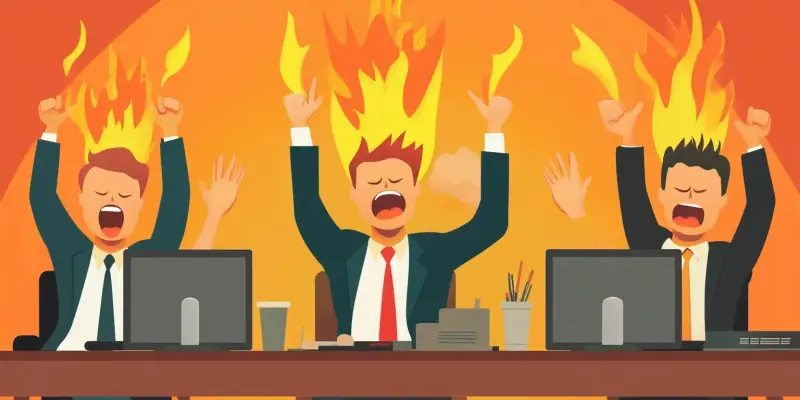As 2025 approaches, a critical issue is making waves across various organizations: manager burnout. This problem isn’t just a passing trend but is projected to significantly impact organizational health and productivity. Multiple surveys, including those conducted by Top Workplaces and Energage, highlight the pressing need for corporate entities to address this growing concern. The findings suggest that manager burnout could become one of the most significant challenges businesses will face.
The Burden of Heavy Workloads
Impact of Extensive Meeting Schedules
Two-thirds of managers are grappling with overwhelming workloads that are significantly intensified by the prevalence of meetings. Managers often spend as much as 75% of their days in meetings, leaving little room for deep work or meaningful engagement with their teams. This excessive focus on meetings not only hampers productivity but also increases stress levels, undermining the quality of decision-making and leadership. Reassessing meeting practices has been suggested by Top Workplaces as a critical step in mitigating this burden. This involves evaluating the necessity of each meeting, ensuring well-drafted agendas, and consolidating or canceling unnecessary sessions.
Reducing the time spent in meetings could drastically improve managers’ ability to focus on essential tasks and reduce stress. It would allow them the opportunity to engage in deep work, strategize, and connect more effectively with their teams. A more balanced approach to managing time would not only alleviate immediate pressures but also foster a healthier work environment. By streamlining these processes, managers can better allocate their energy and resources, leading to higher productivity and job satisfaction across the board.
The Manager Squeeze
Another significant stressor is the “manager squeeze,” a phenomenon where managers find themselves caught between the demands of senior leaders and the needs of their teams. This dual-pressure situation frequently results in managers facing heightened stress and compromised work-life balance. The 2024 Perceptyx report underscores this, revealing that managers score lower in work-life balance compared to executives or individual contributors. This imbalance indicates a clear need for organizational strategies to offer relief and support to managers.
Mitigating the effects of the manager squeeze involves implementing targeted strategies to reduce stress and support work-life balance. Top Workplaces recommends reducing team sizes, streamlining workflows, and cutting down on unnecessary meetings as practical steps. By doing so, managers can better navigate the demands placed upon them and maintain a more sustainable and health-conscious approach to their roles. Ensuring that managers receive adequate support is vital for maintaining overall organizational health and productivity, as well as for reducing the risk of burnout.
Communication Challenges and the Importance of Feedback
Organizational Changes and Communication Gaps
Effective communication is crucial, yet many organizations fall short in informing employees adequately about impending changes. This communication gap leads to resistance rather than support during transitions. Employees often express the need for clarity on changes impacting their roles and seek understanding of the rationale behind leadership decisions. By instituting open dialogues and Q&A sessions, organizations can foster better acceptance and smoother implementation of changes.
Addressing communication gaps requires a proactive approach to keep all team members informed and engaged. Regular updates on organizational changes help build trust and transparency, allowing employees to feel more secure and aligned with the company’s direction. Managers play a pivotal role in this process by relaying critical information and facilitating discussions within their teams. This two-way communication channel not only reduces uncertainties but also empowers employees, thereby reducing resistance to change and enhancing overall morale.
Listening to Employee Feedback
Another essential strategy in combating burnout is actively listening to and acting upon employee feedback. Concerns about burnout, pay, and benefits are critical issues that need attention to build trust and engagement among the workforce. Addressing these concerns demonstrates that the organization values its employees’ well-being, fostering a more inclusive and supportive work culture.
Managers must be equipped with the skills and resources to effectively gather and respond to feedback. This involves regular check-ins and surveys to monitor employee sentiments and identify areas of improvement. By taking tangible actions based on feedback, organizations can create a more positive and motivating work environment. This proactive approach not only reduces the risk of burnout but also enhances employee loyalty and productivity, contributing to the long-term success of the organization.
Generational Differences and Their Effects
Evolving Workforce Dynamics
The workforce’s generational diversity adds another layer of complexity to managing burnout. Older employees typically exhibit higher levels of loyalty, pay satisfaction, and work-life balance. In contrast, younger employees, particularly those from Generation Z, prioritize opportunities for growth, fair compensation, and meaningful work. This dynamic requires managers to adapt their leadership styles to meet the unique needs of different generational cohorts.
This adaptation often involves investing more time and resources to provide direct feedback and developmental opportunities tailored to younger employees’ expectations. Despite their technical proficiency, Gen Z employees frequently require further development in areas such as communication, time management, and teamwork. Upskilling and training can address these gaps, ensuring that all employees, regardless of their generational background, receive the support they need to thrive in the workplace.
Tailoring Management Strategies
As we approach 2025, manager burnout is becoming a significant issue for many organizations. This is not just a temporary concern; it has the potential to severely affect organizational health and overall productivity. Several surveys, including notable ones from Top Workplaces and Energage, underscore the urgent necessity for companies to respond to this escalating problem. These studies indicate that manager burnout could become one of the primary challenges that businesses will face in the coming years. The persistent stress and overwhelming demands placed on managers are taking a toll, leading to exhaustion and decreased efficiency. If this trend continues unchecked, it could have detrimental consequences on both individual well-being and broader organizational performance. Therefore, it is imperative for companies to implement effective strategies to mitigate burnout and support their managerial staff. Addressing this issue head-on is crucial for maintaining a healthy, productive work environment as we move closer to 2025.

